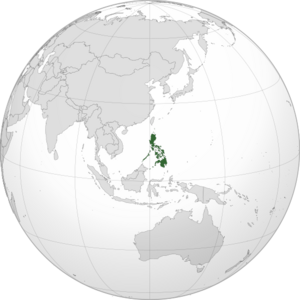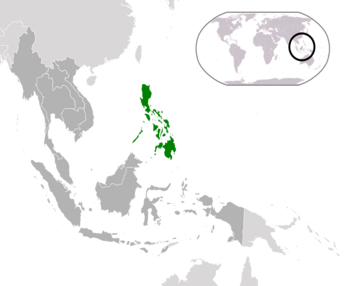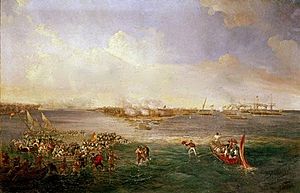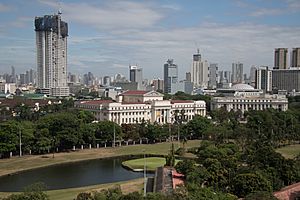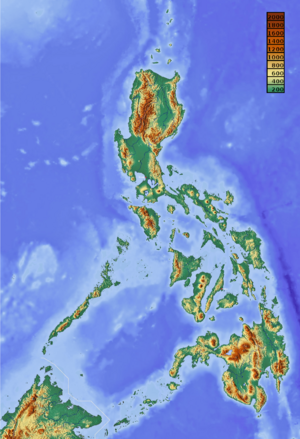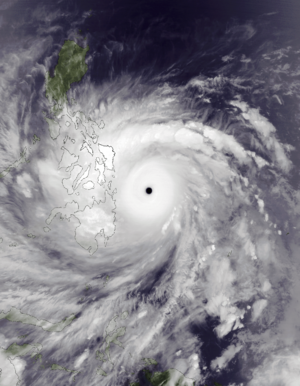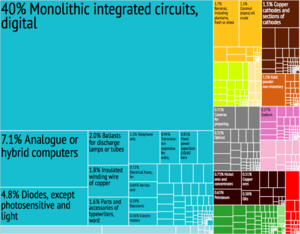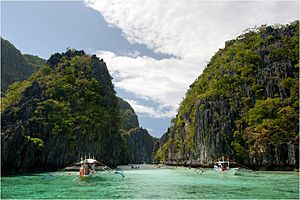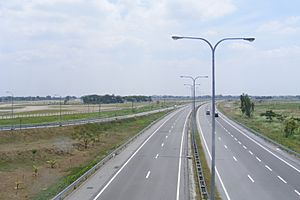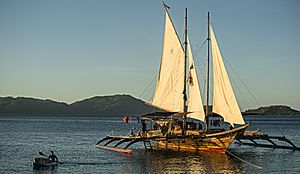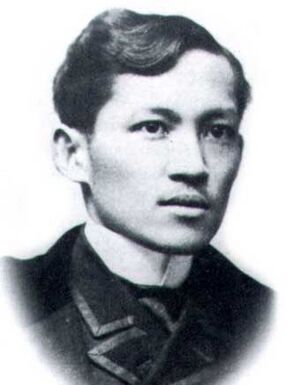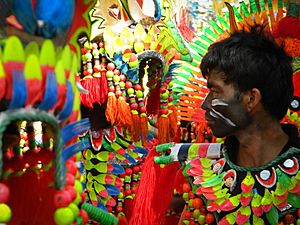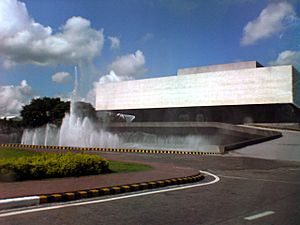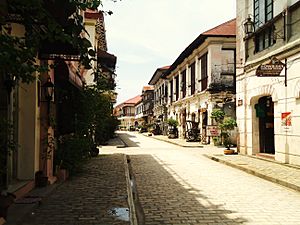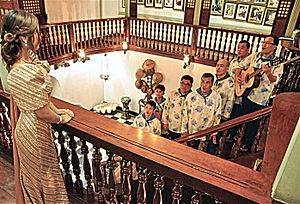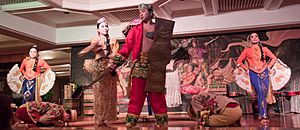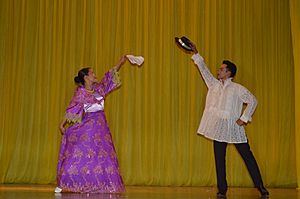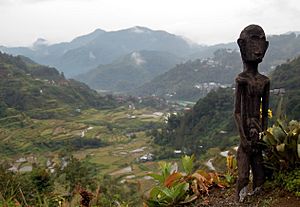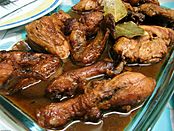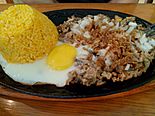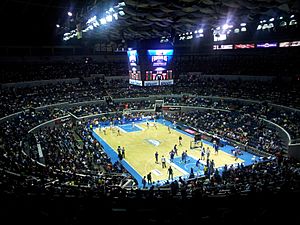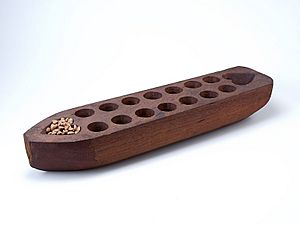Philippines facts for kids
Quick facts for kids
Republic of the Philippines
Republika ng Pilipinas (Filipino)
|
|
|---|---|
|
|
|
|
Motto:
Maka-Diyos, Maka-tao, Makakalikasan at Makabansa "For God, People, Nature, and Country" |
|
|
Anthem: "Lupang Hinirang"
"Chosen Land" |
|
| Capital | Manila (de jure) Metro Manila (de facto) |
| Largest city | Quezon City |
| Official languages |
|
| Recognized regional languages | 19 languages |
|
National sign language
|
Filipino Sign Language |
|
Other recognized languages
|
Spanish and Arabic |
| Ethnic groups
(2020)
|
|
| Religion
(2020)
|
|
| Demonym(s) | Filipino (neutral) Filipina (feminine) Pinoy (adjective for certain common nouns) |
| Government | Unitary presidential republic |
| Bongbong Marcos | |
| Sara Duterte | |
| Francis Escudero | |
| Legislature | Congress |
| Senate | |
| House of Representatives | |
| Independence
from Spain and the United States
|
|
|
• Declaration
|
June 12, 1898 |
|
• Cession
|
April 11, 1899 |
| November 15, 1935 | |
|
• Recognized
|
July 4, 1946 |
|
• Constitution
|
February 2, 1987 |
| Area | |
|
• Total
|
300,000 km2 (120,000 sq mi) (72nd) |
|
• Water (%)
|
0.61 (inland waters) |
| Population | |
|
• 2024 estimate
|
|
|
• 2020 census
|
|
|
• Density
|
363.45/km2 (941.3/sq mi) (36th) |
| GDP (PPP) | 2024 estimate |
|
• Total
|
|
|
• Per capita
|
|
| GDP (nominal) | 2024 estimate |
|
• Total
|
|
|
• Per capita
|
|
| Gini (2021) | ▼ 41.2 medium |
| HDI (2022) | high · 113th |
| Currency | Philippine peso (₱) (PHP) |
| Time zone | UTC+8 (PhST) |
| Date format | MM/DD/YYYY DD/MM/YYYY |
| Driving side | right |
| Calling code | +63 |
| ISO 3166 code | PH |
| Internet TLD | .ph |
The Philippines is an island nation in Southeast Asia. It is located in the Pacific Ocean and has about 7,600 islands. The country was once controlled by Spain (from 1521 to 1898) and then by the United States (from 1898 to 1946). The capital city of the Philippines is Manila.
The Philippines and East Timor are the only countries in East Asia where most people are Christians. The Philippines became fully independent in 1946 after the United States left.
The Philippine Islands are surrounded by the Philippine Sea to the east, the South China Sea to the west, and the Celebes Sea to the south. Nearby countries include Borneo to the southwest, Vietnam to the west, and Taiwan directly north. Palau is to the east of the Philippine Sea.
Contents
History of the Philippines
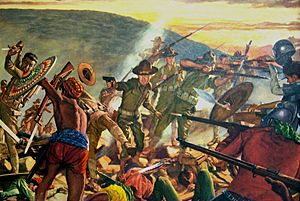
People have lived in the Philippines for thousands of years. Early groups like the Negritos settled on the islands. Later, many Austronesian groups arrived. They either pushed the first people inland or mixed with them.
Chinese traders came to the islands in the 8th century. Powerful Buddhist kingdoms helped trade grow with countries like India, Japan, and other parts of Southeast Asia. When the first Europeans arrived in 1521, led by Ferdinand Magellan, there were local rulers called rajahs. The islands were mostly self-governing.
Spanish Rule and Independence Efforts
In the 16th century, the Spanish, led by Miguel López de Legazpi, claimed the islands. They named the country Filipinas after King Philip II of Spain. The Roman Catholic religion was quickly introduced. The Philippines was governed from Mexico, and trade across the Pacific Ocean began using large ships called galleons. Over the next three centuries, some rebellions happened due to unfair government practices.
In 1781, Governor José Basco y Vargas started a group to help the Philippines become more independent from Mexico. The country began to open up more in the 19th century. A new, more nationalistic Filipino middle class and Chinese-Filipino community grew. They were inspired by the Propaganda Movement to fight against the unfairness of Spanish rule. They asked for independence.
Jose Rizal, a famous leader of this movement, was arrested and executed in 1896. Soon after, the Philippine Revolution began. It was led by the Katipunan, a secret group founded by Andres Bonifacio and later led by Emilio Aguinaldo. The revolution almost succeeded in removing the Spanish by 1898.
American Influence and World War II
In 1898, Spain and the United States fought the Spanish–American War. After the war, Spain gave the Philippines to the United States for $20 million. However, the Filipinos had already declared their independence. This led to the Philippine–American War, which officially ended in 1901. Fighting continued until 1913. Many Filipinos and American soldiers lost their lives during this conflict.
The American government made English the main language in the islands through free public schools. In 1935, the Philippines became a US commonwealth, which gave it more self-governance.
Independence was finally granted in 1946, after World War II. The years that followed had many challenges. People were also unhappy during the time of an unpopular leader, Ferdinand Marcos, who had to leave the presidency in 1986. Later, the country faced ongoing problems with communist groups and groups wanting to separate.
Government and Politics
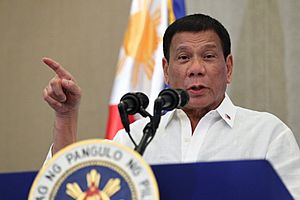
The government of the Philippines is similar to the government of the United States. The President is the head of the country, the head of the government, and the leader of the military. The president is chosen by popular vote and serves for six years. They are also the leader of the cabinet.
The Philippine legislature, called the Congress, has two parts: the Senate and the House of Representatives. Members of both are elected by the people. There are 24 senators who serve for six years. The House of Representatives has up to 250 members, each serving three-year terms.
The judicial branch is led by the Supreme Court of the Philippines. It has a Chief Justice and 14 Associate Justices, all chosen by the president.
The Philippines is a founding member of the Association of Southeast Asian Nations (ASEAN). It is also active in the Asia-Pacific Economic Cooperation (APEC). The Philippines was one of the 51 founding members of the United Nations in 1945.
Regions and Provinces
The Philippines is divided into "local government units" (LGUs). The province is the largest unit. In 2002, there were 79 provinces. Within provinces are cities and municipalities (towns). The smallest unit is the barangay (village).
All provinces are grouped into 17 regions for easier management. Most government offices have regional branches. Regions do not have their own local government, except for the Muslim Mindanao and Cordillera regions, which have special self-governing powers.
Major Cities
Metro Manila is the most populated of the three main metropolitan areas in the Philippines. In 2018, it was the 8th most populated in the world. In 2015, it had over 12.8 million people, which is almost 13% of the country's population. If you include nearby areas, the population is around 24.6 million. More than half of the country's population lives in cities.
Metro Manila's economy was estimated to be ₱468.4 billion in 2009. This makes up 33% of the nation's total economy. In 2011, Manila was ranked the 28th wealthiest city area in the world and the 2nd wealthiest in Southeast Asia.
Geography and Climate
The Philippines is an archipelago made up of about 7,641 islands. Its total land area is about 300,000 square kilometers. With 36,289 kilometers of coastline, it has the fifth longest coastline in the world.
The Philippines is located between 116° 40' and 126° 34' E longitude and 4° 40' and 21° 10' N latitude. It is bordered by the Philippine Sea to the east, the South China Sea to the west, and the Celebes Sea to the south.
Most of the islands are mountainous and covered in tropical rainforest. Many are volcanic in origin. The highest mountain is Mount Apo, which is 2,954 meters above sea level on the island of Mindanao. The Galathea Depth in the Philippine Trench is the deepest point in the country and the third deepest in the world.
The longest river is the Cagayan River in northern Luzon. Manila Bay is connected to Laguna de Bay, the largest lake, by the Pasig River. Other important bays include Subic Bay, Davao Gulf, and Moro Gulf. The San Juanico Strait separates the islands of Samar and Leyte.
Volcanoes and Earthquakes
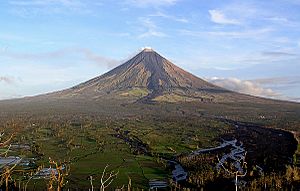
The Philippines is located on the western edge of the Pacific Ring of Fire. This means it often experiences earthquakes and volcanic activity. About 20 earthquakes happen daily, but most are too small to be felt. The last major earthquake was the 1990 Luzon earthquake.
There are many active volcanoes, such as Mayon Volcano, Mount Pinatubo, and Taal Volcano. The eruption of Mount Pinatubo in June 1991 was the second largest volcanic eruption of the 20th century. Not all geological features are destructive. The Puerto Princesa Subterranean River is a beautiful example. It is a habitat for many different plants and animals and has important forests.
Because of the volcanic nature of the islands, there are many mineral deposits. The country is thought to have the second-largest gold deposits after South Africa. It also has one of the largest copper deposits in the world. Palladium and Romblon marble are also found here. The Philippines is rich in nickel, chromite, and zinc.
Geothermal energy is also a big resource. The Philippines is the world's second-biggest producer of geothermal power, after the United States. This energy meets 18% of the country's electricity needs.
Climate and Weather
The Philippines has a tropical climate, which means it is usually hot and humid. There are three seasons:
- tag-init or tag-araw: the hot, dry season or summer (March to May)
- tag-ulan: the rainy season (June to November)
- tag-lamig: the cool, dry season (December to February)
Temperatures usually range from 21°C (70°F) to 32°C (90°F). January is usually the coolest month, and May is the warmest. The average yearly temperature is about 26.6°C (80°F). Higher places like Baguio, which is 1,500 meters above sea level, are cooler. Baguio's average temperature is 18.3°C (65°F), making it a popular place to visit in summer.
The Philippines is in the typhoon belt. Most islands experience heavy rains and thunderstorms from July to October. About 19 typhoons enter the Philippine area each year, and eight or nine make landfall. The local term for a tropical cyclone is Bagyo. The Philippines is very vulnerable to climate change risks.
Economy
The Philippine economy is the 34th largest in the world. In 2018, its total economic output was estimated at $371.8 billion. Key exports include semiconductors and electronic products, transport equipment, clothes, copper products, petroleum products, coconut oil, and fruits.
The country's money is the Philippine peso (₱ or PHP).
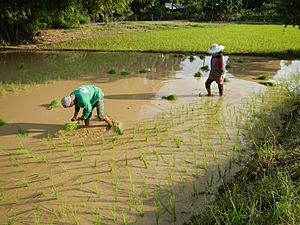
The Philippines is a newly industrialized country. Its economy is changing from being mostly about farming to focusing more on services and manufacturing.
After World War II, the Philippines was one of the wealthiest countries in East Asia, second only to Japan. However, its economic growth slowed down in the 1960s. The economy struggled under an unpopular leader, Ferdinand Marcos, due to poor management. The country faced slow growth and economic downturns. The economy only began to recover in the 1990s with new economic policies.
Service industries like tourism and business process outsourcing (BPO) are growing fast. Tourism could be even bigger, but travel between the many islands can be difficult.
The BPO industry includes areas like call centers, software development, and medical transcription. This industry is very important for the country's growth. The Philippines has recently become a top global center for BPO services, even surpassing India.
Science and Technology
The Philippines is working to improve its science and technology. Research groups like the International Rice Research Institute (IRRI) are important. IRRI was founded in 1960 in Los Baños, Laguna. It focuses on creating new rice types and farming methods to help farmers.
Tourism
The country's rich variety of plants and animals is a big draw for tourists. Its beaches, mountains, rainforests, islands, and diving spots are very popular. With about 7,500 islands, the Philippines has many beaches, caves, and rock formations. Boracay has beautiful white sand beaches and was named the best island in the world in 2012.
Other famous places include the Banaue Rice Terraces in Ifugao, the historic town of Vigan in Ilocos Sur, the Chocolate Hills in Bohol, Magellan's Cross in Cebu, and the Tubbataha Reef in the Sulu Sea. The Philippines is also a favorite place for foreigners to retire. This is because of its warm climate, beaches, and low cost of living.
Transportation
Transportation in the Philippines is still developing. This is partly due to the mountains and scattered islands. Also, past governments have not invested much in infrastructure.
Buses, jeepneys, taxis, and motorized tricycles are common in cities and towns. In 2007, there were about 5.53 million registered vehicles.
The Civil Aviation Authority of the Philippines manages airports and air travel safety. As of 2014, there were 85 public airports.
Major expressways and highways are mostly on the island of Luzon. These include the Pan-Philippine Highway, which connects Luzon, Samar, Leyte, and Mindanao. The Cebu–Cordova Link Expressway in Cebu will be the first expressway outside Luzon, expected to be finished by 2021.
Train travel mainly serves passengers within Metro Manila, Laguna, and parts of the Bicol Region. As of 2019, the country had 79 kilometers of railway. Plans are to expand this to 244 kilometers. New lines are being built, including the Metro Manila Subway.
Since the Philippines is an archipelago, traveling between islands by water is common. This is often done using small to medium-sized boats called bangka. These boats traditionally had sails, but since the 1970s, most use motor engines. These motorized bangka are often called "pump boats." Bangka are still the most common type of boat in the Philippines.
The busiest seaports are Manila, Batangas, Subic, Cebu, Iloilo, Davao, Cagayan de Oro, and Zamboanga. Ferry services connect Manila to various cities and towns. The Strong Republic Nautical Highway (SRNH), established in 2003, connects islands using highways and ferry routes. The Pasig River Ferry Service operates on major rivers in Metro Manila.
People and Languages
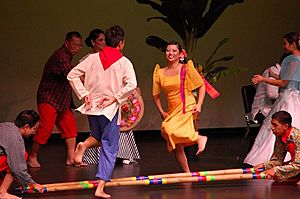
Around 94 million people lived in the Philippines as of 2010. Most Filipinos are of Austronesian descent. There are also Chinese people who have been involved in businesses for centuries. The Negritos live in the mountains of Luzon and Visayas. Luzon has many mestizo people, a Spanish term for those with mixed Spanish and native blood.
The people of the Philippines are called Filipinos. Filipinos are divided into many groups, with the three largest being the Tagalogs, Cebuanos, and Ilocanos. In the past, "Filipino" referred to the Spanish and mixed-race minority. Now, it refers to any citizen of the Philippines. Filipinos are also sometimes called "Pinoy" for short.
Filipino and English are the official languages. Filipino is based mostly on Tagalog, a local language spoken in Metro Manila and nearby provinces. Filipino is related to the Malay language. Other local languages include Cebuano and Ilocano, among many others. English is used in government, schools, and business.
Chinese is spoken by the ethnic Chinese population. Most Muslims in southern Mindanao and nearby islands also speak some Arabic. Spanish, once an official language, is still spoken by a small number of Filipinos.
Culture
Philippine culture is a mix of Eastern and Western influences. It shares traits with other Asian countries that have a Malay heritage. But it also shows many influences from Spanish and American cultures.
Traditional celebrations called barrio fiestas (district festivals) are common. They honor patron saints and are times for feasting, music, and dancing. The Ati-Atihan, Moriones, and Sinulog festivals are some of the most famous.
Some traditions are changing due to modern life. The Bayanihan Philippine National Folk Dance Company works to preserve traditional folk dances. They are known for dances like the tinikling and singkil, which use clashing bamboo poles.
One clear Spanish influence is the common use of Spanish names and surnames. This came from a rule by Governor-General Narciso Clavería y Zaldúa. The names of many streets, towns, and provinces are also in Spanish.
The widespread use of English shows the American impact on Philippine society. This has led to Filipinos embracing American pop culture, like fast food and American movies and music. Fast food restaurants are everywhere. While big American chains are present, local chains like Goldilocks and Jollibee are also very popular.
Architecture
Spanish architecture influenced how many towns were designed around a central square, or plaza mayor. Many buildings from that time were destroyed during World War II. However, some examples remain, especially churches, government buildings, and universities. Four Philippine baroque churches are UNESCO World Heritage Sites: the San Agustín Church in Manila, Paoay Church in Ilocos Norte, Nuestra Señora de la Asunción (Santa María) Church in Ilocos Sur, and Santo Tomás de Villanueva Church in Iloilo. Vigan in Ilocos Sur is also famous for its many Spanish-style houses.
The American period starting in 1898 brought new architectural styles. This led to the building of government buildings and Art Deco theaters. City planning in parts of Manila was done using designs by Daniel Burnham. This plan included government buildings that looked like Greek or Neoclassical architecture. In Iloilo, many colonial buildings from the American period can still be seen, especially on Calle Real.
Some areas, like Batanes, have unique architecture due to the climate. Limestones and coral were used for building. Before the Spanish arrived, Idjangs or Ivatan castles were the main shelters.
Music
Philippine music has changed a lot due to different influences from colonial times. Before the Spanish arrived, most music was inspired by nature. Examples include Koyu No Tebulul of the T'boli and Ambo Hato of the Ifugao. This music often used gongs, and a well-known instrument is the Kulintang.
During the Spanish era, Rondalya music was popular. This uses traditional string instruments like the mandolin. Filipino Rondalya instruments are made from local wood. The 14-string bandurria, found only in the Philippines, is a key instrument. Harana and Kundiman were common songs used in courtship.
Today, American pop culture has a strong influence on Filipino music. Korean pop is also very popular. However, traditional folk music is being revived by groups like the Philippine Madrigal Singers.
Dance
Like music, Philippine dance has also changed over time. Before colonial rule, there were many ethnic dances from different tribal groups across the islands. Luzon and Visayas initially had tribal movements until the Spanish arrived. Mindanao has more Muslim-inspired dances, with Spanish influence limited to the Zamboanga region.
Common dances in the Philippines are performed at social events, rituals, and parties. During the Spanish era, most dances were accompanied by Rondalya music.
One famous dance is the Tinikling. Dancers move between two clashing bamboo poles, often acting out scenes of rural life. The Muslim version of this dance, also using bamboo poles, is called the Singkil.
Cariñosa is a Hispanic Filipino dance, sometimes called the "National Dance." It is a courtship dance where the woman uses a fan or handkerchief to create a romantic scene.
Today, dances range from ballet to street styles like breakdancing.
Visual Art
Pottery and weaving are among the oldest art forms in the Philippines. Examples of ancient pottery, including human-like jars, date back thousands of years. Women often did weaving, using fibers from plants like abaca and pineapple to make clothes, rugs, and hats. Baskets were used to carry grain and other foods.
Values
Filipino values are mainly based on personal connections. These include family, friendship, religion (especially Christianity), and business relationships.
Filipino values often focus on keeping social harmony. People want to be accepted within a group. The main reasons for following these values are Hiya (a sense of shame) and Amor propio (self-esteem). What others think, say, or do strongly influences how Filipinos behave.
Other Filipino values include being hopeful about the future, caring for others, being friendly, being hospitable, being religious, respecting others, respecting women, fearing God, and hating cheating and stealing.
Cuisine
Filipino food has changed over centuries. It started with Malayo-Polynesian roots and now mixes Hispanic, Chinese, American, and other Asian influences. These influences have been adapted to local ingredients. Dishes can be simple, like fried salted fish and rice, or fancy, like paellas for festivals.
Popular dishes include lechón (roasted pig), adobo (meat stew), sinigang (sour soup), kare-kare (oxtail stew), tapa (cured meat), crispy pata (fried pork hock), pancit (noodles), lumpia (spring rolls), and halo-halo (a cold dessert). Common local ingredients are calamansi (a small citrus fruit), coconuts, saba bananas, mangoes, ube (purple yam), milkfish, and fish sauce. Filipino food has strong flavors but is not as spicy as some other Asian cuisines.
Unlike many Asians, most Filipinos do not use chopsticks. They use a spoon and fork. This is because rice is the main food, and many dishes are stews or have broth.
Eating with hands, called kamayan, used to be more common in rural areas. Now, it is becoming popular in cities too, especially in Filipino restaurants. Sometimes, people eat in a "Boodle Fight" style. This is where food is placed on banana leaves for everyone to share.
Sports
Many sports are popular in the Philippines. These include basketball, boxing, volleyball, football (soccer), American football, rugby, badminton, karate, taekwondo, billiards, ten-pin bowling, chess, and sipa. Motocross, cycling, and mountaineering are also becoming popular.
Basketball is played by amateurs and professionals. It is considered the most popular sport in the Philippines.
In 2010, Manny Pacquiao was named "Fighter of the Decade" by several boxing organizations. The national martial art and sport is Arnis, also known as Eskrima or Kali.
The Philippines has participated in the Summer Olympic Games since 1924. It was the first country in Southeast Asia to compete and win a medal. The country has competed in every Summer Olympics since then, except for the 1980 boycott. The Philippines was also the first tropical nation to compete at the Winter Olympic Games, starting in 1972.
Games
Traditional Philippine games like luksung baka, patintero, piko, and tumbang preso are still played by children. Sungka is a traditional Filipino board game. Card games are popular during festivals. Mahjong is also played in some communities.
Cockfighting, called Sabong, is another popular entertainment, especially among Filipino men. It existed before the Spanish arrived. Antonio Pigafetta, who traveled with Magellan, first wrote about this pastime.
The yo-yo, a popular toy, was introduced in its modern form by Pedro Flores. Its name comes from the Ilocano language.
Religion
Most people in the Philippines are Christians, about 92%. The majority (70%) are Roman Catholics. A good number (17%) are Protestants from various Christian groups. Other religions include Members Church of God International (3%), Iglesia ni Cristo (2%), Muslims (5-10%), and Buddhists (2%). There are also some Hindus and other smaller religions.
Other pages
Images for kids
-
The Laguna Copperplate Inscription, the oldest known writing found in the Philippines.
-
Filipino Ilustrados in Spain formed the Propaganda Movement. Photographed in 1890.
-
General Douglas MacArthur coming ashore during the Battle of Leyte on October 20, 1944.
-
Mayon is an active stratovolcano, located in the south of the island of Luzon.
-
The Philippine Eagle is unique to the forests of the country.
-
Founded in 1611, the University of Santo Tomas is the oldest existing university in Asia.
-
Ambuklao Dam in Bokod, Benguet.
-
José Rizal is a pioneer of the Philippine Revolution through his literary works.
See also
 In Spanish: Filipinas para niños
In Spanish: Filipinas para niños




